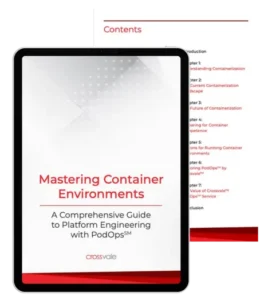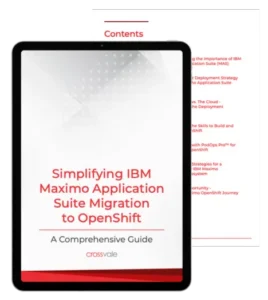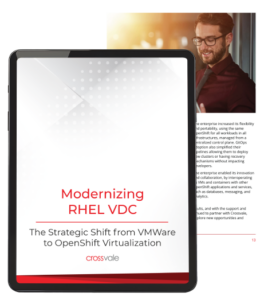Introduction
In the dynamic realm of IT infrastructure, immutable infrastructure has emerged as a game-changer. Typically, when the mention of Immutable Infrastructure is mentioned, it’s in the context of containers, but why? Why should you ditch traditional virtual machines (VMs) in favor of containers when embracing this approach? Let’s explore what’s beyond virtual machines and into the world of containers and Red Hat OpenShift for immutable systems.
Challenges of Using VMs in Immutable Infrastructure
First off, let’s talk VMs. While virtualization has been a staple in IT environments for years, using VMs for immutable infrastructure poses some challenges. VMs are heavyweight, taking up greater resources and time to spin up and tear down. Imagine this: you’re running a web application, and suddenly, there’s a surge in traffic. With VMs, scaling up to meet the demand can be cumbersome and slow, leading to potential performance issues and downtime.
Rise of Containers
Enter containers. Lightweight and portable, containers offer a more agile and efficient solution for immutable infrastructure. Picture this scenario: you’re a developer working on a microservices-based application. With containers, you can encapsulate each component of your application in its isolated environment, complete with all dependencies. This allows for rapid deployment, scaling, and rollback, ensuring seamless updates without disrupting other parts of the application.
Kubernetes: The Backbone of Container Orchestration
Now, let’s talk about Kubernetes and platforms like Red Hat OpenShift. Kubernetes, an open-source container orchestration platform, provides the backbone for managing containerized workloads at scale. It automates the deployment, scaling, and management of containers, allowing for efficient resource utilization and seamless application delivery. Think of it as the conductor orchestrating a symphony of containers, ensuring harmony and balance across your infrastructure. Red Hat OpenShift IS Kubernetes plus plus plus!

But what sets Red Hat OpenShift apart? Well, for starters, OpenShift builds on Kubernetes, adding additional layers of security, automation, and developer productivity. With built-in monitoring, logging, and service mesh integration, OpenShift empowers organizations to streamline their DevOps workflows and accelerate application delivery.
Moreover, OpenShift’s operator framework enables the automation of complex operational tasks, such as database provisioning or application lifecycle management.
Imagine this: you’re a DevOps engineer responsible for managing a fleet of applications. With OpenShift operators, you can define custom automation logic to handle routine tasks, freeing up your time to focus on innovation and strategic initiatives.
So, what does OpenShift provide in regard to security that Kubernetes doesn’t, right out of the box?
Securing Government Infrastructure with Red Hat OpenShift
In environments where security is paramount, such as government agencies or industries with stringent compliance requirements, the need for robust security measures cannot be overstated. Red Hat OpenShift offers a comprehensive suite of security features designed to meet the most rigorous standards and ensure STIG compliance and government-grade security.

Security-Enhanced Linux (SELinux)
Security-Enhanced Linux (SELinux) is a mandatory access control mechanism employed by OpenShift to enforce security policies. By leveraging SELinux, administrators can establish granular controls to prevent unauthorized access or tampering with system resources. This ensures that even if an attacker gains access to a container, they remain confined within a secure environment.
Image Signing and Scanning
OpenShift facilitates the enforcement of policies for image signing and scanning, allowing organizations to verify the authenticity and integrity of container images before deployment. By ensuring that only trusted images are used, this feature helps mitigate the risk of running vulnerable or malicious code, thereby enhancing overall security posture.
Pod Security Policies
With OpenShift, administrators can define and enforce pod security policies to govern the behavior of containers within the cluster. These policies enable organizations to specify constraints such as privileged access, host restrictions, and resource limitations, thereby reducing the likelihood of unauthorized access or resource abuse.
Compliance as Code
OpenShift empowers organizations to define compliance checks as code using tools like Kubernetes Policy Controller or Open Policy Agent (OPA). By codifying security policies, organizations can automate compliance checks and ensure continuous adherence to STIG requirements and other regulatory standards, streamlining the compliance process and enhancing operational efficiency.
FIPS 140-2 Compliance
For organizations requiring FIPS 140-2 compliance, OpenShift offers support for cryptographic modules validated under the Federal Information Processing Standards (FIPS) 140-2. By leveraging FIPS-compliant cryptographic operations, organizations can ensure the highest standards of security and integrity for cryptographic operations within their environments.

VMs have served their purpose in traditional IT environments. Containers and Kubernetes platforms like Red Hat OpenShift and OpenShift Virtualization offer a more agile, efficient, and secure approach to immutable infrastructure. By embracing containerization and orchestration, organizations can unlock new levels of scalability, resilience, and velocity in their software delivery pipelines. So, why settle for the status quo, Virtual Machines, IaaS platforms, and expensive public cloud services when you can embrace the future of infrastructure with containers and Red Hat OpenShift?
For additional insights on transitioning from traditional VM infrastructure to cutting-edge container based VMs, download our eBook, “Bridging Legacy and Innovation: The Compelling Case for Migrating VMware to OpenShift Virtualization.”
Author Ben Silverman
Ben Silverman, a Principal Architect at Crossvale, is a renowned author, technical reviewer, and expert in Virtual Infrastructure and Automation.
With a background in cloud architecture and deployment, Ben has played key roles in prominent organizations such as Mirantis and American Express. His contributions to the Open Infrastructure community extend beyond writing, as he is actively involved in user groups and foundation documentation. Ben holds degrees in English communications and Information Management and is a sought-after speaker on cloud technologies. Ben is available as a Fractional Cloud Architect through Crossvale.








